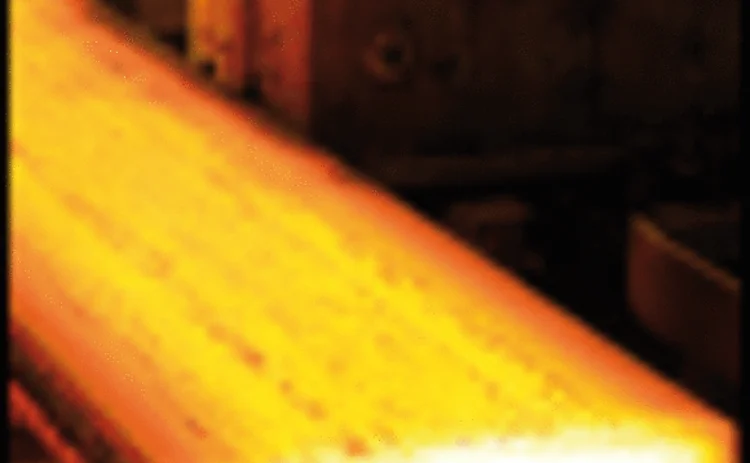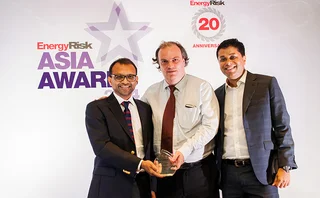
Forging an index
Efforts by miner BHP Billiton to create an iron ore index that would represent the underlying benchmark for a series of derivatives instruments appear to be floundering as Chinese steel producers press hard for pricing advantage. Kathleen Kearney reports

Iron ore and steel prices have sunk to 20-month lows and it is a buyers' market once again. The China Iron and Steel Association (CISA) is trying to make the most of the price trend, rallying the nation's largest steel producers to reject the use of an iron ore price index proposed by BHP Billiton of Australia, one of the largest suppliers to China's booming steel industry.
Market practitioners had pinned their hopes on the adoption of such an index, which would have paved the way for the development of a series of hedging tools. Given the current state of play, they may have to be content with basing new derivatives on steel futures contracts launched in London, Dubai, Chicago and most recently Shanghai.
The CISA has brought together 16 of the major producers of steel under its umbrella and appointed Baoshan Iron and Steel (Baosteel), the nation's largest steel producer and iron ore importer, as the lead negotiator in the 2009-2010 term contract talks with BHP Billiton and Rio Tinto of Australia and Companhia Vale do Rio Doce (Vale) of Brazil.
The Chinese group is comprised solely of state-owned enterprises, largely still majority owned by various state organisations despite being publicly listed. Their aim is to be the global price setter, not a price taker, and take over the role of Japan's large steel producers, which for years dictated the global benchmarks for iron ore and many steel products prices.
"We have prepared our negotiating strategies, and whether there is a fall in prices or no further declines, we won't give up easily," says CISA president Shan Shanghua. The association is currently preparing for a third round of talks with the world's three major suppliers of iron ore, which collectively account for nearly 80% of world iron ore production. Failure to come to an agreement in the first two rounds in November 2008 and February this year was blamed on the delaying tactics of the suppliers and the third round may not take place until May or June, says the CISA.
Regardless of when the next round is held, the association believes the collective demand of its group will be sufficient to pressure iron ore producers. "The larger our demand, naturally the lower the contract price should be. We also will let them compete (among themselves) on price and whoever is cheapest, that is what we will buy," Shan tells Asia Risk.
Strengthening the CISA's position is the fact that its members, which control about half of the domestic China market, sell their production directly to their customers on long-term contracts and so would be eager to book steady, predictable prices into their annual planning budgets, says Ma Haitian, a research analyst at Antaike Information Development Co in Beijing.
At the same time, the iron ore producers see China's four trillion renminbi ($585 billion) stimulus package - with its emphasis on infrastructural development - as one good reason why they should not surrender too cheaply. Indeed, some parties believe China may have already lost its time advantage. Iron ore imports in February rose to 46.74 million tonnes, a 22.4% leap over the same month a year earlier.
Another weakness in the CISA position may be the fact that Baosteel and the others in the CISA negotiating group account for just 50-60% of total national output, says Ma. The remainder is produced by a large number of medium-sized companies, which have not signed up to the CISA strategy.
Second-tier Australia mining company Territory Resources, for example, has signed agreements to sell iron ore to three undisclosed steel producers in China, the company reported on March 24. The parties signed pricing agreements for the next three years, with annual pricing of the ore benchmarked each year against major annual long-term contracts for Western Australian iron ore. This means that whatever price the CISA and Baoshan negotiate with BHP Billiton and the others, Territory Resources will use that price as the base from which to add a premium or a discount in price to the undisclosed buyers. It will continue to sell at the spot iron ore prices for physical delivery until the final binding contracts are completed.
Western Australia ore producer Atlas Iron, one of the smallest iron ore miners in Australia, signed the last of its available iron ore into a long-term offtake agreement with an unidentified Chinese steel mill on March 18, the company said. Atlas has signed an agreement to supply 20% of the iron ore produced at its Pardoo mine in Western Australia to the steel mill over a three-year period to March 2012. The company has in place four offtake agreements with Chinese mills for 100% of the production from Pardoo over the next three years.
In December last year, possibly with a view to strengthening its negotiating position, the CISA reportedly warned domestic steel mills that they risked losing their iron ore import licenses if they accepted index pricing in ore supply deals, according to a report in the Shanghai Securities News. The association, acting with the backing of the central government in Beijing, would insist on them using the existing annual benchmarking pricing systems, such as that used in the Territory Resources deal.
Iron ore price index
The desire for such an index pricing system derives in part from the volatility in prices in the past two years and the doldrums of the price trend in earlier years, says Shanghai-based Yu Yapeng, president of Citic Pacific Special Steel Holdings - Citic Pacific, a speciality steel producer, is not a member of the CISA negotiating group.
Prior to 2002, iron ore and steel prices moved very little. Demand for these raw materials and finished goods in developed countries, which dominated the market, rose at a slow, steady pace. It was a buyers' market and the suppliers of iron ore preferred the certainty of term contracts as insurance of a steady route to their buyers.
With the rise of China's steel industry in 2002, its increased production and seeming voracious demand, prices began to move. In 2008, iron ore prices, including the benchmark rate, hit an all-time high of 1,530 renminbi a tonne in late June 2008, then fell for the following eight month to trade at 570 renminbi on March 27, 2009.
The price volatility in 2008 left the market in chaos. BHP Billiton lost its market advantage and possibly any leverage over its clients for use of its price index. That's because by the end of 2008, spot prices were about 20% lower than term contract prices, and the forecast was for a further decline in prices of as much as 30-40% from the 2008 term contract benchmark price.
On international markets, the iron ore spot price rallied to $90 a tonne (excluding freight charges) in early February, near to the 2008 benchmark price of $99. It then sank below $60 a tonne (including the $7 a tonne freight charge), effectively 40% below the benchmark. In recent years, it is clear that many of the country's smaller steel producers prefer to source their material from the spot market. "Unlike Japan, in China, fewer firms like to use long-term contracts. Many prefer to use the spot market, even though the volatility is greater," says Yu.
For its part, BHP Billiton claims it is promoting but not forcing any of its buyers to adopt a pricing system based on its index, says company spokesperson Samantha Evans in Melbourne. However, BHP Billiton is said to have offered steel mills in China discounts as a way of promoting the use of its index. The other major iron ore producers, meanwhile, are letting BHP Billiton take the lead.
But the composition of the index and how it is updated has not been disclosed in detail. It is likely to be based on cash prices paid in the spot market, plus changes in freight rates calculated daily or weekly. BHP Billiton believes the spot market is a strong indicator of the real supply and demand balance. In its marketing material the company has promoted the use of the index, citing the development of bulk commodity indexes including energy coal indexes. Term contracts can be based on the index, then with development of a forward curve, an over-the-counter swap market would develop that would allow parties to the trade to manage price risk separately from supply risk, says Philip Toth, head of marketing at BHP Billiton in Melbourne.
Hedging tools
Managing price volatility has become a necessity for everyone involved along the steel supply chain. Steel prices have three main underlying variables: iron ore, coal and transport prices. Market practitioners had hoped to use the BHP Billiton iron ore price index as the foundation for the new hedging products, but may have to opt for futures-related products instead.
Hot rolled coil steel futures began trading on New York Mercantile Exchange in October 2008. The contract is cash settled only and therefore attracts a wide range of those within and outside of the steel industries. The underlying product itself, however, is sought by automobile and appliance makers, and therefore is aimed directly at the US market players. The exchange offers 18 consecutive months of futures contracts.
The London Metal Exchange (LME) launched trading of steel billet futures last year. Trading on the Ring commenced on April 28 and the first delivery date was July 29, 2008.The LME's contracts are two regional (Far East and Mediterranean), physically delivered steel billet futures contracts. Steel billet, one of the fastest growing steel markets, is used for reinforcing steel bars (rebars) production.
If liquidity develops in the contracts, the LME could offer options on these futures, therefore attracting wider interest by offering more cost-effective hedging products and risk management tools. The Dubai Gold and Commodities Exchange has a physically delivered contract (Middle East) for rebars.
The Shanghai Futures Exchange, meanwhile, launched trading in four steel futures contracts on March 27, with two rebar and two coiled steel futures contracts offered. In all, time series of five months will be traded, from one month to 12 months, in units of 10 tonnes each. Possibly with the recent market volatility in mind, the exchange has set its circuit breakers for these contracts twice as wide as those on base metals contracts: trading will be halted after a 10% price fluctuation, rather than the 5% move for copper, aluminium, zinc and nickel contracts. Unlike the LME, the Shanghai exchange is unlikely to offer options on these contracts for some time.
All four contracts, however, are likely to suffer in the short term from the reluctance of investors, traders and those in the industry to take up positions while the price trend is still on a downtrend, says Anselm Lee, senior metals trader at Standard Bank in Hong Kong. "Volumes are incredibly low in London ... mainly because commodity prices have been falling and this has discouraged investors."
Only users who have a paid subscription or are part of a corporate subscription are able to print or copy content.
To access these options, along with all other subscription benefits, please contact info@risk.net or view our subscription options here: http://subscriptions.risk.net/subscribe
You are currently unable to print this content. Please contact info@risk.net to find out more.
You are currently unable to copy this content. Please contact info@risk.net to find out more.
Copyright Infopro Digital Limited. All rights reserved.
You may share this content using our article tools. Printing this content is for the sole use of the Authorised User (named subscriber), as outlined in our terms and conditions - https://www.infopro-insight.com/terms-conditions/insight-subscriptions/
If you would like to purchase additional rights please email info@risk.net
Copyright Infopro Digital Limited. All rights reserved.
You may share this content using our article tools. Copying this content is for the sole use of the Authorised User (named subscriber), as outlined in our terms and conditions - https://www.infopro-insight.com/terms-conditions/insight-subscriptions/
If you would like to purchase additional rights please email info@risk.net
More on Metals
Interview: Can Matthew Chamberlain rescue the LME?
London Metal Exchange CEO identifies problems, awaits contract and fee structure revamp feedback
Base metals dealer of the year: BNP Paribas
French bank expands hedging and finance solutions to mainland China
Asia precious metals house of the year: Citi
Citi builds full-service Asia strategy as others exit market
LME Clear ‘welcomes scrutiny’ of CCP risk management
Oversight from clearing members is good for central counterparties, says LME Clear CEO
Metals house of the year: SG CIB
Barclays and Jefferies Bache deals highlight bank’s commitment to metals
Metals traders shun clearing due to Emir, says LME chief
Emir segregated accounts pushing firms to trade OTC, says Jones
LME eyes Asian growth while dealing with regulation
Garry Jones on China, warehouses, clearing and financial regulation
Energy Risk Asia Precious Metals House of the Year: ANZ
ANZ connecting physical players with reach and structuring ability








